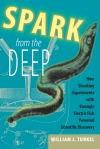Wild Thing is an occasional series where JHU Press authors write about the flora and fauna of the natural world—from the rarest flower to the most magnificent beast.
Guest post by William J. Turkel
Around 1949, while on a visit to the aquarium at the London Zoo, Hans Lissmann noticed that the African fish Gymnarchus could apparently avoid obstacles in its tank while swimming backward. Lissmann had read about these fish decades earlier, when he was doing his doctoral research. He knew that they possessed an organ which appears similar to the one that allows the South American electric eel to generate shocks in excess of 600 volts, stunning or killing animals in the water around it. Unlike the electric eel, however, the electrical discharges of Gymnarchus were very weak. The fish couldn’t stun anything. Moving to another tank, Lissmann stopped to watch an electric eel and observed that it, too, could avoid obstacles while swimming backward. He realized that both animals must somehow be using electricity to sense their surroundings.
Lissmann is usually credited with the discovery of electrosensory abilities in fish, but that is not quite accurate. For centuries, people had been making related observations and suggestions that hadn’t led very far. But Lissmann was the right person to make something of the discovery, in just the right place and time. He was a biomechanics researcher in the zoology department at Cambridge University. He was also a former student of Jakob von Uexküll, who had written about the importance of understanding an animal’s Umwelt, or its subjective experience of the surrounding world. Jet travel made it possible for Lissmann to obtain living animals from the opposite ends of the world—he received a Gymnarchus specimen as a wedding present the following year—and continual advances in electronic instrumentation made it ever easier to study sensory physiology.
Lissmann conducted a series of experiments and field studies to clarify the nature of the electric sense, working first by himself and later in collaboration with the physicist Ken Machin. Eventually, they were able to show that Gymnarchus can detect and locate objects based solely on the imprint that they make on an electric field that the fish generates around itself. They called this measure “imprimence.” A porous, opaque ceramic pot, sealed with cork and rubber, has very little imprimence by itself, so Lissmann and Machin used pairs of these pots to contain substances to test the fish with. Their Gymnarchus specimens could not see or smell the contents of a pot, but they were able to distinguish a pot containing air from one containing wax, and to discriminate between wax and aquarium water, and even between solutions containing different ratios of aquarium water and distilled water. What mattered was the electrical conductivity of the solution or substance: if it was different in the two pots, the fish could detect the difference. But they couldn’t, for example, detect the difference between salty solutions and vinegary ones if the solutions’ conductivity was the same.
There are only a handful of strongly electric fish: some African catfish, marine torpedo rays, and the electric “eels” of South America (not eels at all, but rather a kind of knifefish). These fish posed a problem for Darwin because it was not at all clear to him how their abilities could have evolved. What use was a stunning mechanism that didn’t stun? How could it be preserved and strengthened in a lineage until it became useful? The subsequent discovery that many species of fish can generate weak electric fields and use them for sensing and communication provided the answer: the electric organs of weakly electric fish served other purposes than predation or defense, and thus could be subject to selective pressures.
Spark from the Deep tells the story of how two kinds of animal, fish and people, discovered electric worlds and came to occupy them. In the case of fish, this discovery was clearly evolutionary. But human beings now possess many similar electrical abilities and have developed many new ones. We are surrounded from birth to death by ubiquitous electric and electronic technologies that provide light, heat, cooling, and power for traction, transportation and machining; allow us to communicate instantly at arbitrary distances; expand our senses in every direction and at every scale; record and provide access to the sum of our mediated knowledge; and increasingly perceive, decide, and act in ways that were once the sole domain of the living.
Although rarely presented as such, our electrical abilities owe as much to our biology as those of fish do to theirs. For it is distinctly human to see the world in terms of apparatus, to treat our own sensations, our bodies, and those of other animals as resources that can be disassembled, modified, remixed, rebuilt, and incorporated into new mechanisms. Our long-term experience with strongly electric fish taught us to harness their shock toward instrumental ends, to replicate it, to store it, to use it to probe the boundaries between life and death, animal and machine. We’ve mostly forgotten the animal origins of technologies that now seem quintessentially abiotic, but that doesn’t make their history less bloody or shocking.
 William J. Turkel is is an associate professor of history at the University of Western Ontario. His most recent book is Spark from the Deep: How Shocking Experiments with Strongly Electric Fish Powered Scientific Development.
William J. Turkel is is an associate professor of history at the University of Western Ontario. His most recent book is Spark from the Deep: How Shocking Experiments with Strongly Electric Fish Powered Scientific Development.

